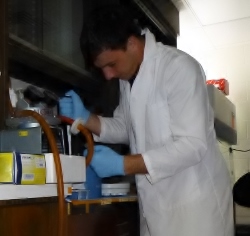Agricultural headwater streams and ditches commonly host dense stands of aquatic vegetation that grow and decay over seasons and exert physical and biological controls on the transport of nutrients from cropland to larger rivers. This study examined changes in the transport of phosphorus (P) in an agricultural drainage ditch in the Maumee River Basin (Ohio, USA) by conducting constant rate injections of a novel tracer mixture (conservative salt [Cl as NaCl], dissolved P [KH2PO4], and a fluorescent fine particle) in spring, summer, and fall. We quantified transport behavior for solutes and particles using a traditional transient storage modeling framework consisting of mobile and immobile storage zones connected by a first-order exchange rate constant. Transient storage was greatest during the spring, when thicker vegetation caused more pooling and flow stagnation, and decreased through fall, as vegetation thinned. Soluble P uptake lengths were 8.7 times longer in fall than spring, likely due to declines in biological uptake rates with colder temperatures and immobile zone storage with thinning vegetation. Particle capture lengths also decreased by a factor of 4.3 from fall to spring. With the increasing eutrophication of Lake Erie and waterbodies around the world that lie downstream from agricultural landscapes, it is beneficial to understand nutrient transport across watersheds, including small agricultural streams. This study highlights the physical and biological roles that aquatic vegetation plays in small agricultural streams by creating seasonally variable immobile zones that slow the flow of nutrients, providing surface area for biofilms, and capturing particles that bind nutrients.
AUTHOR
Zackary Johnson
PI Johnson Lab
68 posts
You may also like
Sara Blinebry joined the team as a research technician whose work will focus on using algae as a source of biofuels. Sara […]
Salmonid feeds can be formulated with high quality microalgae to maintain sustainability in the aquaculture industry. But, the suitability of different microalgae […]
Five large scale ponds, three ~1000L and two ~4500L , have been installed and are growing microalgae as part of the Marine […]
Second year PhD student Courtney Swink was awarded a NSF Graduate Research Fellowship Program Fellowship. Her selection as an NSF Graduate Fellowship […]




